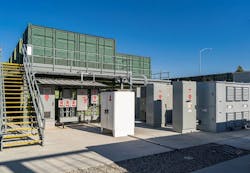Kaiser Permanente Welcomes Solar-Storage Microgrid at Southern California Hospital
Healthcare giant Kaiser Permanente is activating what it calls the largest hospital-based renewable energy microgrid at its medical center in Ontario, California.
More on Healthcare Microgrids in EnergyTech
The Ontario Medical Center microgrid will utilize 2 MW of on-site canopy solar and 9 MWh of non-lithium battery storage capacity and is connected to charge into the state’s electrical grid and provide emergency power at the hospital. The Ontario microgrid also has a 1-MW fuel cell, which can take natural gas or hydrogen and convert it into electricity without combustion.
Kaiser Permanente says that the microgrid supplies clean power for the Ontario hospital’s day-to-day use and emergency backup power during utility grid outages. The microgrid can power the hospital for up to 10 continuous hours during emergency power situations, according to the company.
Faraday Microgrids supplied battery storage components which were funded through an $8.3 million grant from the California Energy Commission, while longtime Kaiser Permanente microgrid partner Ameresco installed the solar power canopies under a power purchase agreement with the company.
It’s all about public health, according to Kaiser Permanente. Fossil-fuel systems create emissions and air pollution which create cardiovascular disease issues for humans.
"We know that pollution and carbon emissions harm people's health,” Bechara Choucair, executive vice president and chief health officer at Kaiser Permanente, said in a statement. “As a health care provider and anchor institution in the communities we serve, Kaiser Permanente has an obligation and an opportunity to protect the health of our members and communities while preventing or mitigating environmental harms."
Kaiser Permanente embraced numerous microgrids across its health system facilities, including a renewable microgrid at the Richmond Medical Center in California nearly eight years ago. The Richmond hospital microgrid includes 250 kW of solar and 1 MWh of battery storage.
The healthcare firm currently has installed on-site solar at more than 100 of its 700-plus locations including hospitals and medical office buildings. One of those more recent medical office building (MOB) microgrids was a project Kaiser Permanente contracted with Ameresco to build solar and battery storage microgrid combination at the West Oahu MOB in Hawaii.
"Every day, we look for new ways to improve the total health of our members and the communities we serve," said Georgina Garcia, senior vice president and San Bernardino County area manager of Kaiser Permanente in Southern California, in the release announced the Ontario Medical Center microgrid. "We know if other hospital systems in the region join us in this effort, we can reduce our industry's environmental burden, ensuring a healthier future for every resident in the Inland Empire."
Ontario Medical Center was named as a “High Performing Hospital” in a U.S. News and World Report for its maternity care standards last year.
Kaiser Permanente owns and operates facilities in eight states and is considered the largest managed care health organization in the U.S.
It is not, however, the only medical care system utilizing microgrid and on-site renewable energy technologies. Two years ago, Valley Children’s Hospital in Medera, California, started a contract with developer Redflow to build a long-duration energy storage microgrid at that facility.
In 2022, Lawrence + Memorial Hospital contracted Bloom Energy to provide a 1.75-MW fuel cell microgrid in New London, Connecticut.
About the Author
Rod Walton, EnergyTech Managing Editor
Managing Editor
For EnergyTech editorial inquiries, please contact Managing Editor Rod Walton at [email protected].
Rod Walton has spent 17 years covering the energy industry as a newspaper and trade journalist. He formerly was energy writer and business editor at the Tulsa World. Later, he spent six years covering the electricity power sector for Pennwell and Clarion Events. He joined Endeavor and EnergyTech in November 2021.
Walton earned his Bachelors degree in journalism from the University of Oklahoma. His career stops include the Moore American, Bartlesville Examiner-Enterprise, Wagoner Tribune and Tulsa World.
EnergyTech is focused on the mission critical and large-scale energy users and their sustainability and resiliency goals. These include the commercial and industrial sectors, as well as the military, universities, data centers and microgrids. The C&I sectors together account for close to 30 percent of greenhouse gas emissions in the U.S.
He was named Managing Editor for Microgrid Knowledge and EnergyTech starting July 1, 2023
Many large-scale energy users such as Fortune 500 companies, and mission-critical users such as military bases, universities, healthcare facilities, public safety and data centers, shifting their energy priorities to reach net-zero carbon goals within the coming decades. These include plans for renewable energy power purchase agreements, but also on-site resiliency projects such as microgrids, combined heat and power, rooftop solar, energy storage, digitalization and building efficiency upgrades.

